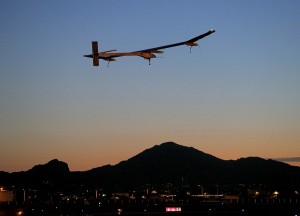
Solar Impulse, piloted by André Borschberg, takes flight during the second leg of the 2013 Across America mission, at dawn, Wednesday, May 22, 2013, from Sky Harbor International Airport in Phoenix. The solar powered aircraft is scheduled to land at Dallas/Fort Worth International Airport on Thursday May 23. The plane’s creators, Bertrand Piccard and Borschberg, said the trip is the first attempt by a solar airplane capable of flying day and night without fuel to fly across America. AP PHOTO/MATT YORK
LOS ANGELES—Solar Impulse, the first aircraft that can fly day and night fueled entirely by energy from the sun, embarked Wednesday on the second leg of its historic journey across the American continent.
The solar-powered airplane departed at 1147 GMT from an airport in Phoenix, Arizona, en route to Dallas, Texas, a trip of about 830 miles (1,300 kilometers), in a bid to set a new world distance record in solar aviation.
The first leg of Solar Impulse’s travel took place on May 3, when Swiss aviator Bertrand Piccard flew the aircraft from the San Francisco, California area to Phoenix.
On Wednesday, Swiss fellow adventurer Andre Borschberg was at the controls flying the craft to Dallas.
The previous distance record, which is already held by Solar Impulse, was attained by Solar Impulse one year ago on a 1,116-kilometer (693-mile) flight from Switzerland to Spain.
The US crossing, taking place in a series of stopovers, is being billed as the plane’s first cross-continent flight.
On the first phase of the continental crossing the plane—which has a slim body and four electric engines attached to enormous wings—flew quietly at an average speed of about 30 miles (49 kilometers) per hour.
Energy provided by 12,000 solar cells powered the plane’s propellers.
The project aims to showcase what can be accomplished without fossil fuels, and has set its “ultimate goal” as an around-the-world flight in 2015.
The plane can fly at night by reaching a high elevation of 27,000 feet (8,230 meters) and then gently gliding downward, using almost no power through the night until the sun comes up to begin recharging the solar cells.
The US itinerary allows for up to 10 days at each stop in order to showcase the plane’s technology to the public. Another stop is planned in the US capital Washington before the trip concludes in New York in early July.
The stopovers will allow Piccard and Borschberg to share duties and rest between flights.
A dashboard showing the live speed, direction, battery status, solar generator and engine power, along with cockpit cameras of both Piccard and his view from the plane, are online at live.solarimpulse.com.

